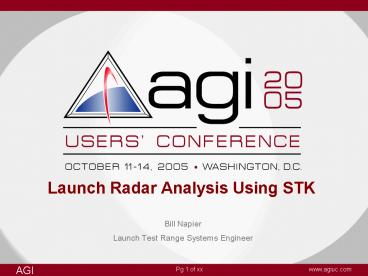Launch Radar Analysis Using STK - PowerPoint PPT Presentation
1 / 11
Title:
Launch Radar Analysis Using STK
Description:
Depicts each site location aspect angle relative to vehicle as a function of flight ... Offset Radar Skin Metric Tracking. All Radars providing metric skin ... – PowerPoint PPT presentation
Number of Views:514
Avg rating:3.0/5.0
Title: Launch Radar Analysis Using STK
1
Launch Radar Analysis Using STK
- Bill Napier
- Launch Test Range Systems Engineer
2
Overview Launch Test Range Systems
- The LTRS supports launches on the USAF Eastern
and Western Ranges
WR
ER
GPS-Based LTRS Requires Enhanced Radar
Architecture
3
Radar Systems Analysis
- LTRS Radar Mission
- Space Object Identification
- Intercept Scoring
- Kill/Lethality Assessment
- Range Safety
- Vehicle GPS Flight Validation
- Boost Phase Debris
- New Foreign Launches
- Launch Vehicles Mission Profiles
- Expendable Delta, Pegasus
- NASA STS / Future CEV
- Evolvable Delta IV, Atlas V
- Analysis process established with STK as the
important cornerstone of the work effort
Analysis Is critical for an Optimized Radar System
4
STK Methodology
STK models Performance and Operational
Effectiveness
5
Launch SRB Modeling
- Electromagnetic wave propagation can be severely
affected by the exhaust plasma from launch
vehicle solid rocket boosters - Degrades radar signals as launch vehicles move up
and away - Reflective RCS dominated by unburned Al2O3
propellant (Slag)
Aspect Angles drives a Radar Location Solution
6
STK Coverage Products
- Launch Aspect Angle Graphs (MATLAB)
- Depicts each site location aspect angle relative
to vehicle as a function of flight - Plume attenuation effect occurs when the site
line is below the threshold angle - Applies until T130 seconds except for
Ballistics/Pegasus, which applies until end of
coverage - Mission Expected Coverage Plans (Excel)
- Depicts each site locations vehicle
line-of-sight and plume effect periods - Constrained to 1.5 degrees elevation
- Radar and Telemetry Systems similarly affected
by plume
Plume Effect Zone
Plume Angle Constraint
7
STK Radar Model
- Launch vehicle
- Constant RCS 0 dBsm
- -4dB Atmospheric Constant
- Radar Open Systems Control Group
- Fixed 160Hz PRF
- Fixed 16 Pulse Integration
- 12 or 25 microsec. Pulse Width
- 1E-8 False Detection Probability
- Antenna
- 16, 29, 50 Foot Diameter
- 320 Degree K System Temp
- Transmitter
- 5.69 GHZ
- 2 MW Peak Power
8
STK Radar Module SNR
- STK Signal to Noise Ratio data is exported to
Excel - Quantifies radar skin track performance
- Predicts quality skin track coverage during boost
phase - Provides a valuable site comparison of radar
performance
Selected Radar Sites
- Acquisition Radar in Plume
- Offset Radar Skin Metric Tracking
All Radars providing metric skin track after SRB
drop
STK Process Provides a Radar Set Selection
9
STK Author / Viewer
- Provides a dynamic evaluation of radar
performance - Visual verification of launch vehicle coverage
and plume effects
WR Delta IV
10
STK Analysis and Radar Selection
- Operational Efficiencies achieved through STK
Analysis - Maximum flight coverage period Early acquisition
- Minimum plume effect Least sensitivity to
exhaust flame effects and slag - Maximum obtainable radar SNR Quality range
safety/user data - Best overall utilization Multiple mission
redundant coverage (in-close off-set radars) - Radar Selection Considerations
- GPS Metric Track risk mitigation
Concept-of-Operations - Standardization of sub-systems (Antenna,
Transmitter, Control Group) - Prioritizes for
- GPS Range
- Range Safety
- RMA data
- Cost/Schedule
Siting Analysis Criteria and Radar Selection
Process Inputs to the Final Radar Architecture
11
Conclusion
- STK-Derived Radar Architecture
- Substantial Radar Quantity Reduction
- Reduced Acquisition and Life Cycle Costs
- Enhanced Utilization in a GPS-based Range
- Team Acknowledgments
- Doug Barnes Radar Program Manager
- Ray Cutshaw Radar Group Supervisor
- Charles Mouille Radar Systems Engineer
STK combined with System Engineering
Processes Ensures an Optimum LTRS Range Radar
System































